
Miscellany (pdf)
|
Environmentally friendly mariculture - challenges of marine fish culture in Mainland China |
|
| Birdbrains in Big Bird Race 2006 | |
|
Kadoorie Farm & Botanic Garden - wildlife updates & sightings |
Kadoorie Farm & Botanic Garden
- wildlife updates & sightings (pdf)
by
Gary Ades, Roger Kendrick, Amanda Haig, Tan Kit Sun,
Peter Paul van Dijk & Captain Wong
General wildlife sightings were posted on the KFBG Wildlife Sightings Board on a fortnightly basis up to mid-April 2006, with records provided by staff and visitors. Many records were generated by the Security team on night shifts. From the middle of April, a new board was introduced at the New Reception, which is updated more frequently with regularly seen wildlife; more unusual sightings are now posted on the KFBG website (www.kfbg.org).
(1) The following sighting records from Kwun Yum Shan (KYS) and elsewhere in KFBG (see map in Porcupine! 33 for locations) were posted between October 2005 and May 2006:
| October 05 |
| 2 October, an adult wild boar with 3 piglets behind the Conservation Building. |
| 8 October, an adult masked palm civet with 5 young civets at the Apiary. |
| 16 October, a Chinese cobra eating a frog below Kwun Yum Shan summit. |
| 26 October, three Malayan porcupine at the Upper Canteen. |
| November 05 |
| 2 November, three young masked palm civets near the Heli-pad. |
| 4 November, a wild boar with 5 piglets at the Parrot Sanctuary. |
| 6 November, two masked palm civet at Magnolia Falls. |
| 10 November, two wild boar at the Golden Pavilion. |
| 15 November, a coral snake at the Apiary. |
| 18 November, a masked palm civet near Orchid Haven. |
| 25 November, three Malayan porcupine near the Upper Canteen. |
| December 05 |
| 2 December, two small wild boar at the heli-pad. |
| 9 December, three wild boar at the Parrot Sanctuary. |
| 13 December, two barking deer near the Post Office Pillars. |
| 17 December, a mother wild boar & 5 piglets near Raptor Sanctuary; one masked palm civet in tree near road junction above Signpost Corner; one Malayan porcupine on the road halfway between Post Office Pillars and the Butterfly Garden; a small Indian (seven banded) civet near the Kadoorie Brothers Memorial Pavilion. |
| 20 December, a mother wildboar with 5 piglets at parrot sanctuary at 00.30. |
| January 06 |
| 2 January, a masked palm civet at the T.S.Woo Pavilion. |
| 10 January, three Malayan porcupine at the Apiary. |
| 17 January, a leopard cat at Cock's Summer Camp. |
| 22 January, a masked palm civet at the Heli-pad. |
| 24 January, flowering trees near T.S.Woo Memorial Pavilion attracted an orange-bellied leafbird, a verditer flycatcher and a forktailed sunbird to feed (Fig. 1). |
 |
| Fig. 1. Orange-bellied Leaf bird, Fortailed Sunbird and Verditer Flycatcher, at KFBG, 24 January, 2006. |
| 26 January, a verditer flycatcher at the Old Deer Haven and Constructed Wetland |
| 27 January, a wild boar with 5 piglets at Great Falls arch. |
| February 06 |
| 3 February, a mother wild boar with four piglets at the Administration Office. |
| 8 February, a masked palm civet at Magnolia Falls. |
| 13 February, three Malayan porcupine at Upper Canteen. |
| 25 February, two Indian moon moths (Actias selene), one at Misha's Bungalow and one at the Butterfly Garden |
| 26 February, a baby Mountain racer snake (Fig. 2) at the Chicken Houses; a juvenile red mountain racer was photographed in the early afternoon near the Norman Wright Chicken House. |
| 27 February, a barking deer at Signpost Corner. |
| 28 February, a mother wildboar with three piglets above the Raptor Sanctuary. |
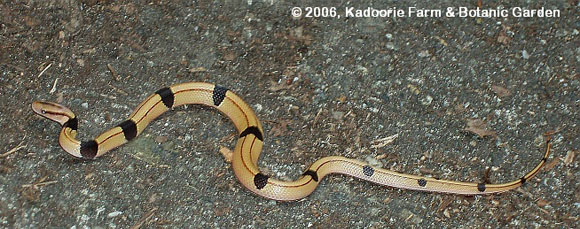 |
| Fig. 2. A juvenile Red Mountain Racer (Photo: KFBG) |
| April 06 |
| 1 April, a Japanese pipistrelle bat; Butterfly Garden - visual and on call with detector; a Himalayan leaf nosed bat; west ridge close to post office pillars - visual and on call with detector; one adult wild boar crossing east ridge road near mandarin orchards; one Malayan porcupine entering rock caves on Western ridge (marked by tracking powder); several collared scops owls calling throughout the Farm; lesser spiny frog; calling in upper stream near Magnolia Reservoir; a Chinese water snake in the Lotus Pond; several Hong Kong newts in the Lotus Pond and lower stream and one masked palm civet on the Eastern ridge road between Orchid Haven and Signpost Corner. |
| 3 April, a yellow-bellied weasel in the lower stream area was photographed by a KFBG visitor Mahler Ka – this is the first confirmed record of this mammal at KFBG and one of only a handful of sightings in Hong Kong (Fig. 3). |
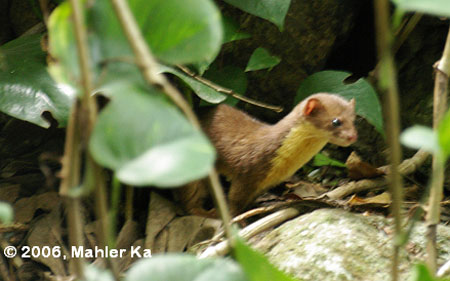 |
| Fig. 3. A yellow-bellied Weasel (Photo: Mahler Ka) |
| 14 April, an atlas Moth at the Lam Kam Road car park pick up / set down area wall. |
| 23 April, a mountain stream snake in the lower stream near the Streamlife Display and an Anderson’s stream snake in the Lotus Pond; several birdwing butterflies (Troides helena) were seen flying in the lower farm area. |
| May 06 |
| 7 May, a Chinese cobra near the Butterfly Garden. |
| 10 May, a young Malayan porcupine was photographed at Orchid Haven. |
In addition to the general sightings, Peter Paul van Dijk, Director of the Conservation International CABS Tortoise and Freshwater Turtle Conservation Program, visited KFBG in early March and made a couple of forays onto the hillside, noting the following:
|
4 March, 21.00-01.00 |
| Hong Kong Newt – at least four individuals seen in pool by Native Mammal Display. One modest-sized adult (male?) animal seen bending its tail forward and fanning towards another, larger animal. |
| Leptolalax cf. pelodytoides – several calling animals heard in upper stream area. Group of three seen besides rock on sand right at water’s edge; photographed. Another calling animal traced to a mud & tree root clump on top of large boulder in streambed (also photographed). |
| Hong Kong Cascade Frog – well over a dozen animals seen on various cascade/waterslide sections in the upper stream, some photographed. Big-headed Turtle – three individuals seen in the upper Farm area. |
| Paa paraspinosa / exilispinosa – almost a dozen animals seen in the upper section of the stream. Magnificent eye shine, very wary, none could be easily approached to within photographing distance. |
| Guenther’s Frog – one small adult seen in stream by Native Mammal Display. |
| Polypedates cf. megacephalum – Several distinctive tadpoles (olive, heavy-bodied, white nose spot) seen in a water lily bowl at the entrance to the Kadoorie Brothers Memorial Pavilion (600 m a.s.l.). |
| Big-headed Turtle - three individuals seen in the upper Farm area. |
| Small mammal, probably civet (based on eye shine, modest size, no hoof sounds but noisy scrambling up steep slope), as well as heard a larger mammal (barking deer? pig?) run off on a slope, and heard a barking deer run off in the orchards, barking several times when it was at a safe distance. |
| 5 March, 20.00-21.00h. |
| Hong Kong Newt – One seen at 14.45 walking on concrete walkway besides Streamlife Display, with a dozen ants crawling over it. Thin animal with regenerated toes on one foot. Removed ants, placed at streamside for photographs, it then walked & swam away into the pool. At night, one large animal seen in koi pond, missing left front foot. Photographed. A few more animals seen in same stream pool as 4 March 2006. |
| Asiatic Common Toad – lots everywhere along the roads, drains, streamside, apparently mostly on the move towards breeding pools. A few calls heard at lower farm area. |
| Hong Kong Cascade Frog – one large animal seen at upper part of stream section visited, on steep waterslide. |
| Guenther’s Frog - Several small individuals at Wildlife Pond, giving ‘kwek’ calls – very small animals for mature calling males – social calls? |
(2) Fauna Conservation Department Project News:
The monthly moth survey [Roger Kendrick]
Light trap recording has taken place on seven evenings or nights between late October 2005 and mid May 2006. At least 440 species were recorded, not including data for the last two sessions awaiting analysis At least one macro moth species was recorded in Hong Kong for the first time: Thinopteryx crocoptera [Geometridae], in the Butterfly Garden on 26 November 2005. In addition, several older records have been verified, resulting in two new species to Hong Kong – Scopula pulchellata [Geometridae] from the Butterfly Garden on 24 April 2003 and Marapana pulverata [Noctuidae] also from the Butterfly Garden on 12 May 2001.
Wild Animal Rescue Centre (WARC) [Amanda Haig, Tan Kit Sun]
The number of birds admitted to the centre over the winter period was less than 1/3 of the usual intake. It is suspected that this may be due to the current Avian Influenza situation where birds are being routed directly to HK Govt animal holding facilities.
The construction of a long-awaited flight (Fig. 4) test cage was completed in late March. Its design, uniquely conceived by Fauna Conservation staff, comprises four recycled China Light Power wooden telephone poles, a cable-suspended soft netting structure and sand covered floor. The design prevents occupants from damaging themselves during flight-testing and can easily be taken down during times of inclement weather to prevent damage.
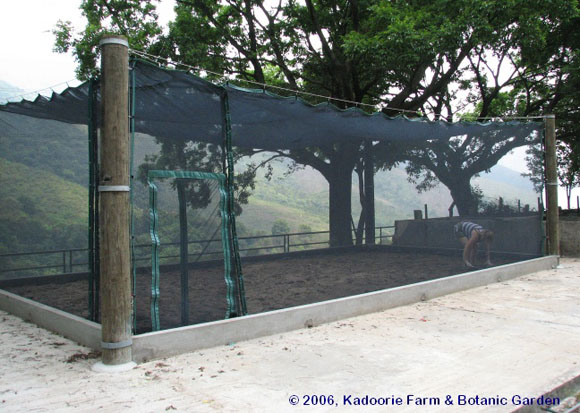 |
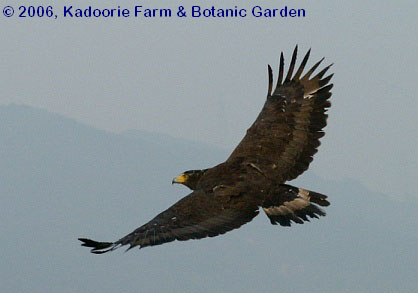 |
| Fig. 4. New flight test enclosure and releasd Crested Serpent Eagle (Photo: KFBG) |
As reported in the last edition of Porcupine!, the Crested Serpent Eagle Spilornis cheela that had suffered a hip fracture having been struck by a truck at Man Kam To made a full recovery and was released in late November 2005.
Animal rehoming to range country organisations involved in captive breeding & conservation projects for those species included:
34 critically endangered Vietnamese pond turtles (Fig. 5), Mauremys annamensis, which included two adults rescued from Hong Kong markets and 32 offspring born in captivity, were returned by Kadoorie Farm and Botanic Garden to Vietnam on 10 May. The returnees and their offspring were transferred to the Turtle Conservation Center (TCC) at Cuc Phuong National Park where the government runs a conservation program for critically endangered species, including the Vietnamese pond turtle. "Eventually, the turtles may be released in central Vietnam where they originated", says Bui Dang Phong, manager of the TCC for Cuc Phuong National Park. Mr. Phong says he is elated to see the turtles finally make it back to Vietnam. See the website link for further information.
http://www.asianturtlenetwork.org/library/ATCN_news/2006_articles/Press_release_ Endemic_Vietnamese_Pond_turtles_come_home_05_06.html
One Large Malaysian Giant Turtle (Fig. 5) (Orlitia borneensis) to Taiping Zoo, Malaysia, where it joins other Orlitia in a large lake.
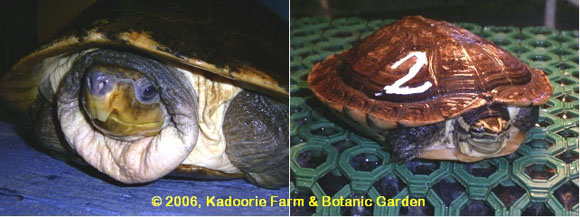 |
| Fig. 5. Rehomed turtles: Malaysian Giant Turtle (left) and Vietnames Leaf Turtle (right). |
Below is a list of some of the animals received by the WARC that have been successfully rehabilitated and subsequently released since mid-October 2005.
|
SPECIES |
LOCATION FOUND |
RELEASE |
RELEASE LOCATION |
|
RAPTORS |
|||
|
Crested Serpent Eagle Spilornis cheela |
Man Kam To |
25.11.05 |
KFBG |
|
Crested Serpent Eagle Spilornis cheela |
Sai Kung |
29.11.05 |
KFBG |
|
Crested Goshawk Accipiter trivirgatus |
Deep Water Bay |
29.12.05 |
KFBG |
|
Common Buzzard Buteo buteo |
Tsing Yi |
29.12.05 |
Fanling |
|
Asian Barred Owlet Galucidium cuculoides |
Lam Tsuen |
01.01.06 |
Lam Tsuen |
|
Oriental Hawk Owl Ninox scutulata |
Kowloon Tong |
03.01.06 |
KFBG |
|
Crested Goshawk Accipiter trivirgatus |
Sai Wan Ho |
18.01.06 |
Fanling |
|
Common Buzzard Buteo buteo |
KFBG |
25.01.06 |
KFBG |
|
Asian Barred Owlet Galucidium cuculoides |
Yuen Long |
07.02.06 |
Yuen Long |
|
OTHER BIRDS |
|||
|
Chinese Pond Heron Ardeola bacchus |
Tsim Sha Tsui |
21.10.05 |
Kam Tin |
|
Chinese Pond Heron Ardeola bacchus |
Wan Chai |
21.10.05 |
Kam Tin |
|
White-rumped Munia Lonchura striata |
Ocean Park |
02.11.05 |
Tai Po Kau |
|
Chestnut Bittern Ixobrychus cinnamomeu |
Causeway Bay |
04.11.05 |
Kam Tin |
|
Eurasian Woodcock Scolopax rusticola |
Sau Ying Pun |
11.11.05 |
Tai Po Kau |
|
Spotted Dove Streptopelia chinensis |
Ocean Park |
11.04.06 |
KFBG |
|
Cattle Egret Ardeola ibis |
Sai Kung |
11.05.06 |
Kam Tin |
|
Red-whiskered Bulbul Pycnonotus jocosus |
KFBG |
18.05.06 |
KFBG |
|
MAMMALS |
|||
|
Asiatic Lesser Yellow House Bat Scotophilus kuhlii |
Launtau |
26.01.06 |
KFBG |
(3) Other News
Lepidoptera Conservation Symposium (Roger Kendrick)
As reported in Porcupine! 33, KFBG will host the first South East Asian Lepidoptera Conservation Symposium between the 4 and 8 September 2006.
Key speakers include leaders in their field at the regional and global level. They include:
-
Prof. Roger Kitching (Griffith University, Australia, a renowned invertebrate conservationist and tropic forest ecologist who has visited DEB in the past);
-
Dr. J. Holloway (author of Moths of Borneo – the most complete documentation of moths in Asia and a proponent of using moths as biological indicators);
-
Dr Li Hou Hun (author of Gelechiidae of China);
-
Dr. Yen Shen-horn, National Sun Yat Sen University, Taiwan, a specialist in the moth families Crambidae and Zygaenidae, as well as supervising many projects of Lepidoptera taxonomy and conservation;
-
Dr. Wang Min, South China Agricultural University, Guangzhou, China; Lycaenid expert and supervising students studying a range of lepidopterous conservation and taxonomic issues;
-
Representatives of Penang Butterfly Farm, the foremost such business in S.E. Asia with a conservation remit.
Anyone interested in participating in the symposium should contact the Fauna Conservation Department at fauna@kfbg.org. Further information on the symposium is available on-line at
http://asia.geocities.com/hkmoths/SEALCS2006/.
Sham Chung –updates (Captain Wong)
The Sham Chung wetland (Fig. 6) was destroyed and converted into a golf-course turf area in 1997 (Porcupine! 19). This wetland was regarded as one of the top five freshwater wetlands in Hong Kong in 1996 and it was identified as one of the 12 ecological hotspots in the New Hong Kong Nature Conservation Policy in 2004 [for related article, see p. 27].
Since its destruction in 1997, the lowland has been further trashed through mangrove cutting, unauthorized river training and further farmland destruction. However, no enforcement action has been undertaken, as most areas are designated private lands and no suspects have been observed during enforcement activities.
On 3 February 2006, a Development Permission Area (DPA) plan was gazetted. This offers statutory authorization for the Planning Department to undertake enforcement and prosecution in regard to unauthorized developments on private lands. The planning intention of Sham Chung, a pocket area surrounded by Sai Kung West Country Park, is to conserve the areas of high significance and rural character, as well as to maintain the unique landscape and cultural heritage of the area. According to this plan, Sham Chung will provide housing for 570 people.
In the DPA plan, Sham Chung is zoned as follows:
-
"Conservation Area" (16.09 ha): hillside, a lowland stream in the southwest and farmlands on higher ground,
-
"Green Belt" (2.67 ha): Villages at the foot of the hills at the boundary of the Country Park,
-
"Agriculture" (8.33 ha): the turf area (previous freshwater wetland) in the south and some lowland streams,
-
"Village Type Development" (V-zone, 2.64 ha): villages in the east; coastal wetland; abandoned fields in the north, and part of a lowland stream, and
-
"Coastal Protection Area" (2.64 ha): mangrove and coastal wetland
Drawbacks
1. Inappropriate zoning of habitats
According to the findings of a KFBG site visit on 29 March 2006, the coastal wetland is zoned as "V-zone" and "Agriculture", while a lowland stream with mature riparian vegetation also falls within the boundary of "V-zone". Coastal wetland and lowland stream areas are not ideal places to build small houses.
2. The environmental "vandal" benefits
Most of the previous freshwater wetland area is zoned as "Agriculture". If it had not been converted to grow turf in 1997, no one could argue against the wetland being zoned as a "Conservation Area" due to its high ecological value. Areas zoned as "Agriculture" are often considered as ‘landbanks’ for further development.
3. Sham Chung - a small town?
Like similar planning forecasts in the rural NT, the projection of 570 residents at Sham Chung is unrealistic. No one is likely to build small houses at a place with no access road.
Taking the case of Tai Long Wan as an example, although the Planning Department’s population projections dropped from 200 in October 2001 to 117 in 2006, the actual rural population is still less than 10! This indicates that demand for small house development in remote areas with poor access, i.e., no road, is very low, although land has already been reserved for them.
So, why do we need to reserve a large area for a population of 570 residents that does not and is unlikely to ever exist? Also, how many small houses and how much infrastructure should be built for housing this expected population? Is this a good use of taxpayers’ money? Could the natural beauty, biological diversity and rural character of Sham Chung still be preserved if there are 570 residents?
4. Stream protection - buffer area
It is good to note that a lowland stream is zoned as a "Conservation Area" due to the presence of rare freshwater wildlife. However, as there is no buffer area to separate the stream from the nearby "Agriculture" area, any inappropriate agricultural activity could cause a direct impact on the aquatic wildlife in the stream.
Another side to the story
While green groups suggest keeping Sham Chung as natural as possible, the SCMP reported on 18 April that there is plan to include a helicopter landing pad (later denied by the planner), a holiday camp, a resort-style hotel, houses, a picnic area, a private club, a Catholic church, a recreation centre and sport centres at Sham Chung. These urbanization developments are claimed to be compatible with the area's rural setting, and amazingly with the recognition of Sham Chung as one of the 12 sites under the New Nature Conservation Policy. This seems completely illogical!
Recommendations
Apart from zoning the lowland habitats as green zones, the "V-zone" boundary could be much reduced as re-development of old houses at the original villages in land zoned proposed as Green Belt may meet the demand, if any. It is also suggested that the Town Planning Board should encourage wetland restoration at the previous freshwater wetland area by giving a ‘green’ zoning to this disturbed area.
Further Information
An in-depth article on this issue has been published in the April 2006 issue of Green Country (volume 59, pp 2-9).
 |
| Fig. 6. Shum Chung today. |
P.31-35
|
Porcupine! |
 Copyright © 2000 |
